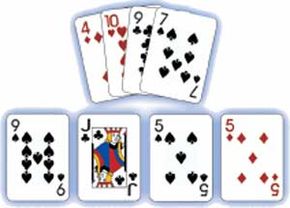As far back as 1797, Casino was described in books on card games. Though the game has quite a few details, it's easy to learn and fun to play, with lots of suspense and surprise. Here's how to play:
Number of players: Two
Advertisement
Object: To score points by taking cards.
The cards: Standard 52-card deck
Playing: Deal four cards to each player and four cards faceup on the table. Dealer keeps the rest of the pack handy. Nondealer plays a card first; players then alternate until the round is over. You can combine the card you play with cards on the table in many possible ways.
Matching: If your card matches by rank a card on the table, you can take the pair immediately. Place the two cards facedown in front of you on the table. Face cards can be taken only with other face cards and only in pairs -- if two queens are on the table and you hold another queen, you can take only one of the queens. However, if three matching face cards are on the table and you hold the fourth, you can take all four.
Combining: If your card equals the combined sum of two or more cards on the table, you can take those cards immediately.
Building: If at least one free card on the table, plus the card you play, totals the number of a card in your hand, announce this build number and pile up the build to take later. For example, if there is a 6 on the table and you have a 3 and a 9 in your hand, you could play the 3 onto the 6 and say "Building 9s." On your next turn, if your opponent hasn't taken it, you can take the build with your 9.
Your opponent can change the value of a build by playing another card. In this case, opponent can play an ace on the build and say "Building 10s." This tells you he or she has a 10 with which to take the build.
But if your 9 build is still there and if you have two 9s in your hand, on your next turn you can put one of them on top of the build and say, "Still building 9s," intending to take the build with your remaining 9. This creates a double build. Players can't change the value of a double build.
Once you have made a build, on your next turn you must take the build, add to the build, or make a new build. Leaving a build untaken runs the risk that opponent will take it, but you may leave a build behind as long as you can add cards to it or make another play. Nothing prevents you from taking opponent's build; you can do so if you have the right card. On the other hand, nothing prevents your opponent from taking your build!





Trailing: You may also play a card by trailing it -- placing it on the table without building it onto another card. You can't do this if you have made a build that's still on the table. You must trail a card if you can't do anything else on your turn. For strategic reasons, a player might want to trail a card onto the table even though it matches the rank of one already there.
After the first round of four cards, dealer deals another round of four cards each and nondealer again plays first. Continue dealing four-card rounds until the pack is depleted, with dealer announcing "last" on the last round. Whoever makes the last take of the last round gets any cards left on the table.
Play to 21 points or to any other agreed-upon number.
Tips: Keeping track of what's been played -- particularly the spades and points you've taken in -- is critical in Casino.
Until it's been played, a certain amount of tension revolves around the 10, Big Casino. As nondealer, if you have the 10, you risk losing it if you can't take it in. (Dealer will probably save any 10 as the final card of the round.) Beware of building 10s when your own 10 is not the 10.

If you are dealt any of the four aces or the 2, your best chance of taking them in is through building. Test your opponent's hand with a double build. Suppose you're holding an Ace, a 3, and a 6, and on the table are a 3 and a 5. You'd really like to take the Ace for the point. First you play the 3 on the 3, saying "Building 6s." If opponent doesn't take it, on your next play you place you Ace on the 5 to make a double build of 6s -- subsequently picking up the lot with your 6.
You can often rack up more points by concentrating on winning cards and spades rather than on the Big Casino and Little Casino.
As dealer, if you are dealt a face card on the last round, you are virtually guaranteed to get last card, since you play last.
Advertisement
